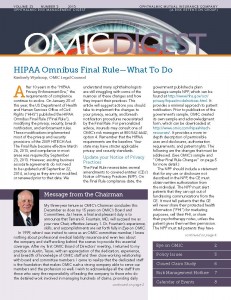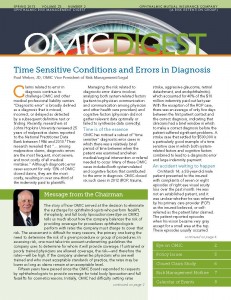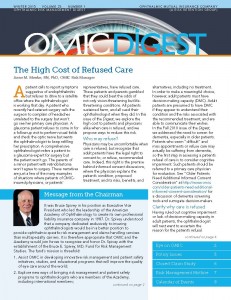OMIC Digest Archives 2013
Why OMIC eliminated the surcharge for cosmetic procedures
 The story of how OMIC arrived at the decision to eliminate the surcharge for ophthalmologists who perform facelift, rhinoplasty, and full body liposuction (see Eye on OMIC) tells us much about how the company balances the risk of providing coverage for procedures ophthalmologists perform with rates the company must charge to cover that risk. The assessment is difficult for many reasons, the primary one being the need to determine the risk of a given procedure or group of procedures. In assessing risk, one must take into account underwriting guidelines the company uses to determine for whom it will provide coverage. If untrained or poorly trained physicians are allowed coverage, the risk—and therefore the rates—will be high. If the company underwrites physicians who are well trained and who meet acceptable standards of practice, the rates may be lower as long as claims remain at an acceptable level.
The story of how OMIC arrived at the decision to eliminate the surcharge for ophthalmologists who perform facelift, rhinoplasty, and full body liposuction (see Eye on OMIC) tells us much about how the company balances the risk of providing coverage for procedures ophthalmologists perform with rates the company must charge to cover that risk. The assessment is difficult for many reasons, the primary one being the need to determine the risk of a given procedure or group of procedures. In assessing risk, one must take into account underwriting guidelines the company uses to determine for whom it will provide coverage. If untrained or poorly trained physicians are allowed coverage, the risk—and therefore the rates—will be high. If the company underwrites physicians who are well trained and who meet acceptable standards of practice, the rates may be lower as long as claims remain at an acceptable level.
Fifteen years have passed since the OMIC Board responded to requests by ophthalmologists to provide coverage for total body liposuction and full facelifts for cosmetic reasons. Initially, OMIC had difficulty setting rates for these procedures because claims data was lacking, and there were no proven underwriting criteria that allowed staff to determine who should be insured. Accordingly, premiums were based on average rates charged by other carriers for cosmetic procedures. OMIC selected a 200% surcharge for coverage of full facelifts and a 160% surcharge for coverage of liposuction. Staff immediately developed underwriting criteria and simultaneously began monitoring claims and tracking incident reports for these procedures. This information was reviewed periodically. Over time, the data confirmed that OMIC’s experience was sufficiently favorable that a rate reduction to 150% of basic premium (i.e., a 50% surcharge) could be adopted. This rate went into effect in 2006. Coverage for rhinoplasty, subject to review and approval of a supplemental questionnaire, adherence to underwriting requirements, and payment of the 50% cosmetic surcharge, was added in late 2008.
OMIC’s conservative approach to underwriting and strong claims performance compared to its peer companies has allowed OMIC to provide coverage for members of the American Academy of Ophthalmology at competitive rates and to embrace new procedures as ophthalmologists begin to perform them. PRK, LASIK, refractive lens exchange, Intacs, facelifts, rhinoplasty, and total body liposuction are examples of procedures OMIC covers at standard rates without surcharge. Elimination of the surcharge means a significant rate reduction for ophthalmologists who perform these procedures. This is good news for those now insured by OMIC and those considering a switch to OMIC and demonstrates how OMIC works on behalf of Academy members to provide coverage at reasonable rates for the work ophthalmologists are doing.
John W. Shore, MD, Chairman of the Board
Surcharge Eliminated for Cosmetic Procedures
At its May meeting, the OMIC Board of Directors voted to eliminate the premium surcharge for ophthalmologists who perform facelift, rhinoplasty, and full body liposuction for policies effective on or after May 1, 2013. The decision was based upon favorable underwriting and claims data tracked by OMIC since the company first approved coverage for these procedures over 15 years ago.
During a recent retrospective review of OMIC-specific and industry-wide claims data, it became evident that the risk exposure for these cosmetic procedures was lower than expected and that OMIC’s experience outperformed that of the industry. Only one claim and two incidents involving facelift procedures have been reported to OMIC since 1997. All three were resolved without indemnity and total expenses paid were $698. Two claims involving liposuction were reported against OMIC-insured physicians. One closed without indemnity and the other settled for $150,000. Expenses for the two claims totaled $24,715. A third claim involving liposuction was brought against an OMIC-insured surgery center for a procedure performed by an open-access member. No rhinoplasty claims have been reported to OMIC to date.
Cosmetic surgery has become safer in the past decade thanks to new “minimally-invasive,” “non-invasive,” or “non-surgical” techniques that carry significantly less risk than more traditional techniques. Continuing medical education courses have given ophthalmologists desiring to add these procedures to their practice the skills and training necessary to do so successfully.
Elimination of the surcharge means that ophthalmologists who perform facelift, rhinoplasty, and total body liposuction will now pay the same rate for professional liability coverage through OMIC as their colleagues who limit their surgery to traditional ophthalmic procedures. This rate is far below what a plastic surgeon, otolaryngologist, or other specialist must pay for similar coverage.
Time Sensitive Conditions and Errors in Diagnosis
Paul Weber, JD, OMIC Vice President of Risk Management/Legal
Digest, Spring 2013
Claims related to error in diagnosis continue to challenge OMIC and other medical professional liability carriers. “Diagnostic error” is broadly defined as a diagnosis that is missed, incorrect, or delayed as detected by a subsequent definitive test or finding. Recently, researchers at Johns Hopkins University reviewed 25 years of malpractice claims reported to the National Practitioner Data Bank between 1986 and 2010.1 Their research revealed that “… among malpractice claims, diagnostic errors are the most frequent, most severe, and most costly of all medical mistakes.” Although diagnostic error cases account for only 13% of OMIC closed claims, they are the most costly, resulting in over one-third of the indemnity paid to plaintiffs.
Managing the risk related to diagnostic error claims involves analyzing both system-related factors (patient-to-physician communication and communication among physician and other health care providers) and cognitive factors (physician did not gather relevant data optimally or failed to synthesize data correctly).
Time is of the essence
OMIC has noticed a subset of “time sensitive” diagnostic error cases in which there was a relatively brief period of time between when the patient was examined and when medical/surgical intervention or referral needed to occur. Many of these OMIC cases included both system-related and cognitive factors that contributed to the error in diagnosis. OMIC closed six such cases in 2012 (ROP, trauma, stroke, aggressive glaucoma, retinal detachment, and endophthalmitis), which accounted for 40% of the $10 million indemnity paid out last year. With the exception of the ROP case, there was an average of only five days between the first patient contact and the correct diagnosis, indicating that clinicians had a brief window in which to make a correct diagnosis before the patient suffered significant problems. A stroke case that settled for $500,000 is a particularly good example of a time sensitive case in which both system-related factors and cognitive factors combined to lead to a diagnostic error and large indemnity payment.
An accident waiting to happen
On March 14, a 53-year-old male patient presented to the insured with complaints of seven or eight episodes of right eye visual acuity loss over the past month. He was not an established patient, and it was unclear whether he was referred by his primary care provider (PCP) as the insured believed, or self-referred as the patient later claimed. The patient reported episodes when his vision became very gray except for a small area at the top. These episodes usually occurred when bending over or straining, lasted four to five minutes, and were sometimes followed by a slight pain in the right eye. The eye exam was essentially normal except for a posterior, subcapsular, polar senile cataract. The patient was noted to be in good general health and oriented to person, place, and time. Since these episodes occurred when the patient bent his neck or strained, the insured believed these actions caused plaques to break off and float to the ophthalmic artery or caused vascular compression. The insured’s diagnosis was transient arterial occlusion of the retina. He instructed the patient to be seen by the referring PCP within two weeks for a workup of transient ischemic attacks (TIA). The patient was told that the PCP would most likely order a carotid ultrasound, and he was advised to “phone immediately for increased pain, increased redness, or decreased vision.” Customarily, the insured’s office would have made the patient’s appointment with the PCP but did not in this case for reasons that are unclear.
The insured sent a letter to the PCP regarding his examination and discharge instructions. The letter stated that the patient had been having amaurosis fugax episodes in the right eye for a few weeks. The PCP later testified that she never received the insured’s letter and, unbeknownst to the insured, the patient had not been seen by this PCP for over four years and was not considered a “current patient.”
A few days after being seen by the insured, the patient had another episode of transient vision loss but did not seek medical attention. One week later, on March 21, the patient collapsed at work. He was taken by ambulance to a large medical center presenting with slurred speech and left-sided weakness. A CT scan of the brain taken in the ER showed a hyper-dense clot in the right cerebral artery, consistent with acute occlusion. There was no evidence of hemorrhage. A bilateral carotid Doppler performed on the same day showed near total occlusion of the right internal carotid artery and 50–60% lesion on the left internal carotid artery. The patient had a cerebral vascular accident (CVA) due to a cerebral clot.
After discharge and rehabilitation, the patient had minor left upper extremity dexterity problems and transient issues with executive cognitive functioning. He filed a lawsuit against the insured, alleging that given the number of episodes of amaurosis fugax, the insured should have referred him for an appropriate workup by a neurologist within 24 to 48 hours. The venue of the lawsuit was “plaintiff friendly” and the jury verdict range was estimated between $1 million and $2.5 million.
OMIC retained three different neuro-ophthalmologists to review the case. One of these experts wanted to be supportive but felt the history taken was a “little lean.” He also stated that “common sense” and “intuition” should have given the insured a sense of urgency regarding the seven or eight events in a one month period. Another expert stated that the insured too quickly ruled out “transient visual obscuration” from the differential diagnosis and that the insured’s theory of “plaque breaking off” and flowing through the carotid artery was a powerful argument for immediate care. The third neuro-ophthalmologist, who testified for the insured, stated that a work-up for amaurosis fugax is not “urgent” or “emergent” when several episodes have occurred over the course of a month or so and are not accompanied by other, more worrisome symptoms. All three experts agreed that had a Doppler ultrasound been ordered quickly, it would have identified the source of the clot at the base of the carotid artery and a surgical correction would have prevented the CVA.
Since the insured was a general ophthalmologist, OMIC also had a general ophthalmologist review the case. She opined that there should have been an urgent (same day) referral to the PCP. She felt strongly that if the PCP could not or would not see the patient, the patient should have been referred to the ER for emergent evaluation, including a neurology consult.
A non-binding hearing was conducted and found that the insured breached the standard of care by not referring the patient to the PCP on a more urgent basis within 24 to 48 hours. However, the hearing panel determined that the plaintiff was more at fault than the insured for not acting sooner to take care of himself, i.e., not making the appointment with the PCP. Also, the panel felt that the patient could have had the stroke at any time, including during the insured’s examination or immediately after he left his office, and that it was speculative whether the stroke could have been avoided. Given the hearing panel’s decision on the standard of care, the consensus of defense counsel, OMIC’s claims department, and the insured was that it was too risky to go to trial and the matter was settled with a $500,000 indemnity payment to the plaintiff.
System-related factors
A “perfect storm” of missed opportunities contributed to the delay in diagnosing the cerebral clot. First, the insured and his staff had different understandings about whether the patient was referred by his PCP or self-referred. The insured erroneously believed that the PCP had referred the patient and, therefore, knew about the episodes of vision loss. The insured also said it was highly unusual for his staff to field a call of vision loss and not make an appointment on a more urgent basis, although there were no written office policies or telephone guidelines for handling appointments.
Had the insured checked the OMIC website, he would have found comprehensive written telephone policies and procedures that would have provided his staff with a checklist to help them gather the necessary information from the patient and determine the appropriate appointment category: emergent, urgent, or routine. Checklists become especially important with time sensitive conditions such as neuro-ophthalmic problems. To this insured’s credit, he made several changes in his appointment practice protocol as a result of this case, including a daily review of all referrals and accompanying paperwork to verify that appointments are scheduled appropriately.
Another system-related issue that frequently impacts time-sensitive conditions is poor communication between provider and patient regarding the nature and urgency of the patient’s condition. The patient in this case claimed not to understand the importance of the follow-up appointment with the PCP and testified that he thought someone would call him with a date for the carotid ultrasound. Even though the hearing panel believed the insured had communicated the urgency of the problem and the patient was primarily responsible for not following up more quickly with his PCP, the case would have been more defensible had the office actually made the referral appointment for the patient. If they had, they would have learned that the PCP was not currently treating the patient, which might have led the ophthalmologist to treat this patient as more high risk. At a minimum, the practice should have given the patient a form specifically indicating the urgency of the appointment.
As noted here and in the Closed Claim Study regarding pseudotumor cerebri, some patients are not fully engaged in the process of their own care. Many ophthalmic practices do a good job of educating and empowering their patients on certain procedures and risks. The American Academy of Ophthalmology patient education brochure “Floaters and Flashes—A Closer Look” is an example of ophthalmologists educating patients to seek timely follow-up care and medical advice and to become active participants in their own care and diagnostic process.
Cognitive factors
In the past few years, the research and literature on diagnostic error have grown significantly. In 2007, Boston hematologist-oncologist Jerome Groopman vividly described in his bestseller “How Doctors Think” how thought processes underlie many diagnostic errors. Cognitive psychologists and researchers who have analyzed diagnostic error believe physicians use a “dual process” to arrive at a diagnosis using both “System 1,” an intuitive/subconscious process, and “System 2,” a systematic, analytical process. When using System 1, physicians employ mental shortcuts (heuristics) to reach decisions that are right the majority of the time. The insured in the stroke case later acknowledged several cognitive processing errors, biases, and limitations linked to System 1 shortcuts.
First, the patient’s general good health alleviated concern about the amaurosis fugax being urgent or emergent. The insured saw the patient in the context of an otherwise healthy 53-year-old man. This is an example of “context error,” which can occur when the diagnosing physician is biased by patient history, previous diagnosis, or other factors and thus formulates the case in the wrong context.
Second, the fact that the patient’s symptoms occurred mostly when he was bending over caused the insured to give too much weight to a diagnosis of transient arterial occlusion. The neuro-ophthalmology experts pointed out that the insured’s own patient history was incomplete and he did not develop a differential diagnosis, too quickly coming to the conclusion of transient arterial occlusion. This is an example of “premature closure.” The insured narrowed his choice of diagnostic possibilities (i.e., hypotheses) too early in the diagnostic process, such that the correct diagnosis was minimized or not considered.
Finally, the insured himself felt the biggest lesson he had learned was to consider the most serious potential diagnosis and let it drive the plan. To improve his understanding of neuro-ophthalmic risk, the insured participated in several CME courses related to transient visual loss and diagnosis and management of neuro-ophthalmic emergencies.
In order to reduce System 1 (intuitive) cognitive processing errors and related biases, some experts suggest a checklist. A copy of several sample checklists can be found at https://orlando.isabelhealthcare.com/pdf/EducationStrategiesToReduce
DiagnosticError.pdf.
Checklists are simply a reminder to perform a conscious, reflective review to optimize clinical decision making and provide corrective oversight to the automatic processing that underlies diagnostic errors such as the one demonstrated in the stroke case.
Error in diagnosis is a challenge facing all of medicine. Multiple factors, system-related and cognitive, are involved. OMIC believes that only with sustained research to better understand these multiple factors will interventions be developed to reduce errors that cause injury to patients and result in claims against physicians and other health care providers.
1. Saber, Tehrani AS, Lee HW, et al. “Quality and Safety in Health Care.” First published online April 22, 2013 as doi: 10.1136/bmjqs-2012-001550.Additional Benefits: Broad Regulatory and e-MD Protection
Kimberly Wynkoop, OMIC Legal Counsel
OMIC is pleased to announce that the Broad Regulatory Protection and e-MD Protection coverages provided in OMIC’s Professional and Limited Office Premises Liability Insurance policy have been enhanced for 2013 at no additional charge. This article is a summary; for a complete review of your coverage, please refer to the OMIC policy. For more information on the BRP and e-MD benefits, see OMIC’s website at http://www.omic.com/policyholder/benefits/.
Peer review coverage
OMIC’s Broad Regulatory Protection (BRP) reimburses insureds for legal expenses relating to regulatory proceedings, which include billing errors, DEA, EMTALA, HIPAA, covered licensing, and STARK proceedings. BRP also covers fines or penalties related to billing errors, EMTALA, HIPAA, and STARK proceedings. While OMIC’s policy already covered actions by regulatory agencies and state licensing authorities under its Disciplinary Proceeding Protection and BRP, in 2013, it added peer review bodies to the list. Under BRP, OMIC now reimburses legal expenses for professional review actions by the review body of a hospital or other health care facility that could adversely affect the insured’s clinical privileges there.
e-MD additions
As insureds continue to move more of their records, communications, and marketing online, coverage for cyber liability risks becomes more crucial. OMIC’s e-MD Protection now provides seven different coverages. One of the 2013 additions is Multimedia Liability Coverage. It covers claims made against the insured for the display of any electronic or print media by the insured that directly results in defamation, invasion of privacy, plagiarism, or copyright infringement.
Another new coverage is Network Asset Protection. It covers digital assets loss, that is, the expenses necessary to restore or replace the insured’s damaged or stolen data and computer programs, because of accidental damage, operational mistakes, or a computer crime that an insured failed to prevent. It also covers the insured’s income loss and interruption expenses incurred during the time it takes to restore these digital assets.
e-MD Protection now also includes Cyber Extortion and Cyber Terrorism Coverages. Under Cyber Extortion Coverage, OMIC pays money to stop the person responsible from executing a credible threat to release confidential information or corrupt the insured’s computer system. Cyber Terrorism Coverage pays income loss and interruption expenses during a period of restoration of the insured’s computer system required because of an act of terrorism.
e-MD enhancements
While the following provisions are not new, they have been enhanced. The e-MD Security and Privacy Liability Coverage covers claims made against the insured for security and privacy wrongful acts. The Security and Privacy Regulatory Defense and Penalties Coverage covers legal expenses and regulatory fines, penalties, or compensatory awards the insured must pay because of such acts. Many acts fall within the definition of security and privacy wrongful acts. For example, a security and privacy wrongful act occurs if an insured fails to prevent unauthorized access to or infection of the insured’s computer system (a “security breach”) that results in destruction of electronic data stored on the insured’s computer system, unauthorized disclosure of confidential information that is in the insured’s care, or unauthorized access to a computer system other than the insured’s. The insured’s failure to prevent the transmission of computer viruses from the insured’s to a third party’s computer system is also a security and privacy wrongful act. A privacy breach, i.e., a breach of confidence, a violation of rights to privacy, or a violation of laws associated with the control of personally identifiable financial or medical information, also constitutes a security and privacy wrongful act.
The Security and Privacy Breach Response Costs, Notification Expense, and Support and Credit Monitoring Expense Coverage now covers the cost of employing a public relations consultant to mitigate damage to the insured’s reputation due to a publicized report of a privacy or security breach. It also covers the expenses of notifying affected individuals in the event of such a breach. Finally, it pays for the provision of customer support in the event of a privacy breach, including credit file monitoring and identity theft assistance.
The BRP and e-MD per proceeding/claim and aggregate limit is $50,000. The BRP and e-MD Protection coverages also include a two year extended reporting period if the insured acquires tail coverage for the policy.
If you have questions about these policy benefits, please call 800.562.6642, ext. 661. If you need to report a proceeding or claim, contact OMIC’s Claims Department at 800.562.6642, ext. 672.









